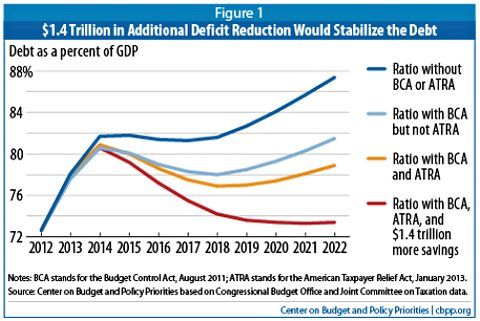“Punting the Pundits” is an Open Thread. It is a selection of editorials and opinions from around the news medium and the internet blogs. The intent is to provide a forum for your reactions and opinions, not just to the opinions presented, but to what ever you find important.
Thanks to ek hornbeck, click on the link and you can access all the past “Punting the Pundits”.
Follow us on Twitter @StarsHollowGzt
Paul Krugman; Coins Against Crazies
It’s crucial to understand three things about this situation. First, raising the debt ceiling wouldn’t grant the president any new powers; every dollar he spent would still have to be approved by Congress. Second, if the debt ceiling isn’t raised, the president will be forced to break the law, one way or another; either he borrows funds in defiance of Congress, or he fails to spend money Congress has told him to spend.
Finally, just consider the vileness of that G.O.P. threat. If we were to hit the debt ceiling, the U.S. government would end up defaulting on many of its obligations. This would have disastrous effects on financial markets, the economy, and our standing in the world. Yet Republicans are threatening to trigger this disaster unless they get spending cuts that they weren’t able to enact through normal, Constitutional means. [..]
Or, best of all, there might be enough sane Republicans that the party will blink and stop making destructive threats.
Unless this last possibility materializes, however, it’s the president’s duty to do whatever it takes, no matter how offbeat or silly it may sound, to defuse this hostage situation. Mint that coin!
New York Times Editorial: America’s Health Disadvantage
It is no secret that the United States spends a lot more on health care than any other country yet ranks far behind other advanced nations in keeping its citizens healthy. This has been well documented in studies of older people and of newborn infants. It is now shockingly clear that poor health is a much broader and deeper problem than past studies have suggested.
An authoritative report issued by the Institute of Medicine this week found that, on average, Americans experience higher rates of disease and injury and die sooner than people in other high-income countries. That is true at all ages between birth and 75 and for even well-off Americans who mistakenly think that top-tier medical care ensures that they will remain in good health. The study found that even upper-income Americans with health insurance and college educations appear to be sicker than their peers in other rich nations.
Last week, I said that if Congress has to make cuts, we should embrace the idea of ridding ourselves of wasteful giveaways to the fossil fuel industry. Here’s an idea. Let’s cut the Master Limited Partnership loophole and fossil fuel subsidies.
The Master Limited Partnership is an obscure but harmful multibillion dollar loophole that allows fossil fuel companies to avoid all income taxes on transportation or processing of fossil fuels — things like oil pipelines. [..]
The Master Limited Partnership is just one example of the billions of dollars in handouts that polluters get from Congress. [..]
It’s time for Republicans in Congress to put their money where their mouth is. Middle class families should not be forced to scrape by with less while oil companies get away with more. Any cuts we make should reflect our priorities and needs as a country. Rather than cutting important lifelines like Medicare, Medicaid and Social Security, let’s cut corporate tax loopholes. The five largest oil companies made more than $1 trillion in profits in the last decade. They don’t need our help.
Ray McGovern: Excusing Torture, Again
Would-be tough guys like former CIA torturer-in-chief José A. Rodriguez Jr. brag that “enhanced interrogation” of terrorists – or doing what the rest of us would call “torturing” – has made Americans safer by eliciting tidbits of information that advanced the search for al-Qaeda leader Osama bin Laden.
Rodriguez makes this case again in the Sunday’s Washington Post Outlook section in the context of the new “hunt-for-bin-Laden” movie, “Zero Dark Thirty,” though Rodriguez still disdains the word “torture.” He’s back playing the George W. Bush-era word game that waterboarding, stress positions, sleep deprivation and other calculated pain inflicted on detainees in the CIA’s custody weren’t really “torture.” [..]
Yet, while quibbling with some details of the movie and its gory depiction of “enhanced interrogation techniques,” Rodriguez largely agrees with the film’s suggestion that the harsh tactics played a key role in getting the CIA on the trail of bin Laden’s courier who eventually led Seal Team 6 to bin Laden’s hideout in Abbottabad, Pakistan. [..]
But others familiar with the chronology of events dispute that the “enhanced interrogation techniques” were responsible for any significant breaks in the case. Sens. Dianne Feinstein and Carl Levin, chairs of the Senate Intelligence Committee and the Armed Service Committee respectively, have asserted that “The original lead information had no connection to CIA detainees” and a detainee in CIA custody who did provide information on bin Laden’s courier “did so the day before he was interrogated by the CIA using their coercive interrogation techniques.”
Eugene Robinson: Is It Hot Enough for You?
All right, now can we talk about climate change? After a year when the lower 48 states suffered the warmest temperatures, and the second-craziest weather, since record-keeping began?
Apparently not. The climate change denialists-especially those who manipulate the data in transparently bogus ways to claim that warming has halted or even reversed course-have been silent, as one might expect. Sensible people accept the fact of warming, but many doubt that our dysfunctional political system can respond in any meaningful way.
Robert Reich: Debt Ceiling and Guns: Using Presidential Authority to the Fullest
Anyone who thinks congressional Republicans will roll over on the debt ceiling or gun control or other pending hot-button issues hasn’t been paying attention.
But the president can use certain tools that come with his office — responsibilities enshrined in the Constitution and in his capacity as the nation’s chief law-enforcer — to achieve some of his objectives. [..]
But it’s a fair argument that when the nation is jeopardized — whether in danger of defaulting on its debts or succumbing to mass violence — a president is justified in using his authority to the fullest.
The mere threat of taking such actions — using the president’s executive authority to pay the nation’s bills or broadly interpret gun laws already on the books — could be useful in pending negotiations with congressional Republicans.

 On January 11, 1908, U.S. President Theodore Roosevelt
On January 11, 1908, U.S. President Theodore Roosevelt 


Recent Comments